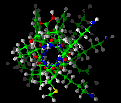 Index to BTCL Commands
Index to BTCL Commands
Listed by function or alphabetically.
Explanation of how
commands are documented.
Molecular Operations and I/O
- begin
- read in the molecular system and the forcefield
- molGeom
- get and set geometric properties of molecules
- readFile
- read in a data file
- reset
- reread the molecular data files and forcefield
- subStructure
- list all atoms connected to an atom that are not also bonded to a
second atom
- writeFile
- write a data file
Calculations
- atomMovability
- set and unset movability characteristics of atoms
- cellParameter
- get and set cell parameters
- dynamics
- perform molecular dynamics simulations
- energy
- perform a single energy evaluation and calculate first and second
derivatives
- energyContribution
- pass energy and energy gradient contributions from user-defined
TCL routines to the Discover program
- forcefield
- select a forcefield, change and scale the contributions from
various energy terms
- minimize
- refine the structure of a molecular system
- rattle
- set up constraints in bonds, angles, or water molecules for a
dynamics run
- restraint
- create, delete, and scale restraints on relationships among atoms
Analysis and Output
- analyzeNonbond
- calculate and examine repulsive, dispersive, and electrostatic
energy components of individual atoms and total nonbond interaction
energies between sets of atoms
- diffraction
- calculate the X-ray, neutron, or electron scattering pattern
- history
- manipulate the history information from a dynamics run
- output
- control the amount of printing to the output file
- print
- write out information for various system properties
- vibrationalAnalysis
- perform normal mode analysis
Database Operations
- database
- perform operations on databases
- $dbHandle
- used to access data within a database
- object
- extract or print information from a BTCL object variable
- pseudoAtom
- create, access, and update pseudoatoms
- select
- create a list of row numbers from a hierarchial database
- subset
- create or access subsets of objects in a database
Geometry and Math Operations
- geometry
- create, review, and manipulate geometry objects
- vector
- for vector manipulation
Miscellaneous
- help
- print information about commands
- ipc commands
- commands for interprocess control
- peek
- control the monitoring of iterative processes in minimization
and dynamics calculations
 Main
access page
Main
access page  Advanced-Use access.
Advanced-Use access.
- analyzeNonbond
- calculate and examine repulsive, dispersive, and electrostatic
energy components of individual atoms and total nonbond interaction
energies between sets of atoms
- atomMovability
- set and unset movability characteristics of atoms
- begin
- read in the molecular system and the forcefield
- cellParameter
- get and set cell parameters
- database
- perform operations on databases
- $dbHandle
- used to access data within a database
- diffraction
- calculate the X-ray, neutron, or electron scattering pattern
- dynamics
- perform molecular dynamics simulations
- energy
- perform a single energy evaluation and calculate first and second
derivatives
- energyContribution
- pass energy and energy gradient contributions from user-defined
TCL routines to the Discover program
- forcefield
- select a forcefield, change and scale the contributions from
various energy terms
- geometry
- create, review, and manipulate geometry objects
- help
- print information about commands
- history
- manipulate the history information from a dynamics run
- ipc commands
- commands for interprocess control
- minimize
- refine the structure of a molecular system
- molGeom
- get and set geometric properties of molecules
- object
- extract or print information from a BTCL object variable
- output
- control the amount of printing to the output file
- peek
- control the monitoring of iterative processes in minimization
and dynamics calculations
- print
- write out information for various system properties
- pseudoAtom
- create, access, and update pseudoatoms
- rattle
- set up constraints in bonds, angles, or water molecules for a
dynamics run
- readFile
- read in a data file
- reset
- reread the molecular data files and forcefield
- restraint
- create, delete, and scale restraints on relationships among atoms
- select
- create a list of row numbers from a hierarchial database
- subset
- create or access subsets of objects in a database
- subStructure
- list all atoms connected to an atom that are not also bonded to a
second atom
- vector
- for vector manipulation
- vibrationalAnalysis
- perform normal mode analysis
- writeFile
- write a data file
 Main
access page
Main
access page  Advanced-Use access.
Advanced-Use access.
Copyright Biosym/MSI
 Index to BTCL Commands
Index to BTCL Commands Index to BTCL Commands
Index to BTCL Commands Main
access page
Main
access page  Advanced-Use access.
Advanced-Use access.  Main
access page
Main
access page  Advanced-Use access.
Advanced-Use access.